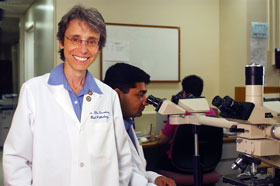  |
| HOME | THIS ISSUE | CALENDAR | GRANTS | BACK ISSUES | < BACK | NEXT > |
Getting to the root of dental diseaseOral pathologist helps clinicians reach diagnoses, treat patientsby Kristina Goodnough - August 28, 2006 |
||||
| As director of the state's only Oral Pathology Biopsy Service, Dr. Ellen Eisenberg helps pinpoint disease so clinicians can properly diagnose and treat literally thousands of people in and around the state of Connecticut. Small samples of tissue or lesions from the mouth and jaw arrive at the Health Center by the dozen every day, sent by dentists and doctors from around the state and throughout the Northeast.
Armed with a microscope, Eisenberg and her colleague, Easwar Natarajan, examine the samples to determine the nature of each specimen. "We determine both what the tissue is [for example, a piece of mucosa, gland, or bone], and the nature of the abnormal condition," says Eisenberg, one of several hundred board-certified oral pathologists in the country. "You cannot treat a condition effectively until you know what it is." Usually within 24 hours or receiving the specimen, Eisenberg and Natarajan report their results to the referring physician. The service has grown dramatically in recent years. When Eisenberg arrived at the Health Center in the late 1970s, the service received about 2,000 samples a year. "Last year, we received more than 4,400 specimens, most of them from outside the Health Center," says Eisenberg, who earned her dental degree from the University of Pennsylvania School of Dental Medicine and completed a residency in oral medicine and oral pathology at Harvard with a clinical fellowship sponsored by the American Cancer Society. "Today, there is generally greater awareness, not only of oral disease but of our ability to analyze and diagnose a wide variety of conditions," she says. Eisenberg takes some credit for that. She has been involved in the education of generations of dentists, many of whom stayed in Connecticut to practice after graduation. "Many of the dentists and physicians who are sending specimens to the biopsy service trained here or did their residencies here at the Health Center," she says. "They use the service because they understand it and trust it, and they tell others about it." It is not just specimens under the microscope that attract Eisenberg's attention. She also sees patients who are referred for diagnostic consultation and management of oral lesions. Every Thursday during the academic year, she is accompanied in her clinic by a small group of students who are learning from her years of experience. "Abnormalities of the oral cavity can be extremely difficult to diagnose," says Eisenberg. "It's not unusual for us to see patients who have had their condition for a long time without receiving an accurate diagnosis or effective treatment. That's why our oral pathology services are so important. Our problem-solving skills rely on a variety of tools and technologies that help us discover clues that determine the fundamental nature of the disease." Eisenberg also teaches the comprehensive oral pathology didactic course to third-year dental students. "Every year I am absolutely amazed by the students' transformation as they gain a thorough understanding of oral disease and the various diagnostic and treatment possibilities related to it," she says. "Being a dentist is not just about drilling and filling. There is a vast array of conditions that can cause abnormalities in the mouth, from common inflammatory irritants and microbial infections to autoimmune diseases and cancer. "As the students begin to understand the panorama of illnesses that affect the mouth and jaw, they really begin to see and understand their role as a dentist," she adds. "It is an amazing journey of growth and awareness."
|
| ADVANCE HOME UCONN HOME |

